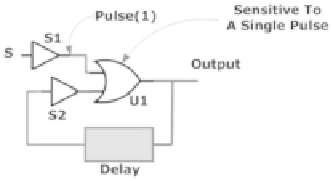Information Technology Reference
In-Depth Information
Fig. 4.3
Recursive neural
circuit
indefinitely keeping its shape because of membrane activity, and because delay
permits the membrane to recover before the pulse appears again. S2 ensures that the
pulse propagates clockwise. Once created, a circulating pulse gives a true signal at
the output; with no circulating pulse the output defaults to a false signal, that is, rest
at about
70 mV.
Delay is affected mainly by the length of the path of the circuit and also by such
parameters as membrane capacitance, makeup of the membrane, and local ionic
concentrations. Note it differs fundamentally from a ring oscillator of digital
technology, which depends on a cascade of inverters connected in a ring. It also
differs in that neural membranes produce very much slower propagations than
metallic conductors, roughly 15 ms per centimeter in dendrites.
Initially all neurons are at their rest potential (
70 mV). A pulse introduced for
cycling reaches up to about +40 mV with a duration of perhaps 2 ms. What is
interesting about a recursive neuron is that memorization would be instant and
theoretically could last indefinitely. But there are open questions.
The main question is, would recursive neurons operating nonstop, consume
excessive energy? Indeed the brain does dissipate significant calories, 10-20 % of
all body calories (for a body at complete rest). But losses in series resistance of
neurons are low because of the relatively slow rise and falls of a neural pulse, so a
pulse does not consume major amounts of energy in series resistance. In this regard
neurons are relatively efficient compared to solid-state logic.
However, membrane conductance has losses in proportion to the average voltage
across the membrane.
1
On average, losses in the membrane conductance are
balanced by a lethargic process of metabolic energy delivery via oxygenated
hemoglobin. Recursive neurons, like any other neuron, would take energy, and of
course, a lot of energy is available. The presence of a cycling pulse implies an actual
reduction in conductive energy dissipation.
Multivibrators and their modifications have important applications, such as
simulated qubits and controlled toggling, discussed later in this chapter.
1
Membrane loss is known to go down during a burst of pulses, since pulsing actually decreases
average membrane voltage from
70 mV up to nearly 0. This leaves behind greater amounts of
oxygenated hemoglobin so as to explain in part why neural activity gives a brighter region in
functional magnetic resonance imaging (fMRI), as mentioned again in a later chapter.

Search WWH ::

Custom Search